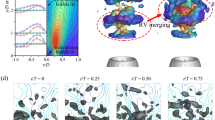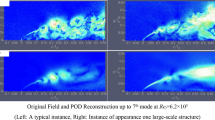Abstract
Dynamic mode decomposition (DMD) analysis was performed on a large number of realizations of the separated flow around a finite blunt plate, which were determined by using planar time-resolved particle image velocimetry (TR-PIV). Three plates with different chord-to-thickness ratios corresponding to globally different flow patterns were particularly selected for comparison: L/D = 3.0, 6.0 and 9.0. The main attention was placed on dynamic variations in the dominant events and their interactive influences on the global fluid flow in terms of the DMD analysis. Toward this end, a real-time data transfer from the high-speed camera to the arrayed disks was built to enable continuous sampling of the spatiotemporally varying flows at the frequency of 250 Hz for a long run. The spectra of the wall-normal velocity fluctuation, the energy spectra of the DMD modes, and their spatial patterns convincingly determined the energetic unsteady events, i.e., St = 0.051 (Karman vortex street), 0.109 (harmonic event of Karman vortex street) and 0.197 (leading-edge vortex) in the shortest system L/D = 3.0, St = 0.159 (Karman vortex street) and 0.242 (leading-edge vortex) in the system L/D = 6.0, and St = 0.156 (Karman vortex street) and 0.241 (leading-edge vortex) in the longest system L/D = 9.0. In the shortest system L/D = 3.0, the first DMD mode pattern demonstrated intensified entrainment of the massive fluid above and below the whole plate by the Karman vortex street. The phase-dependent variation in the low-order flow field elucidated that this motion was sustained by the consecutive mechanisms of the convective leading-edge vortices near the upper and lower trailing edges, and the large-scale vortical structures occurring immediately behind the trailing edge, whereas the leading-edge vortices were entrained and decayed into the near wake. For the system L/D = 6.0, the closely approximated energy spectra at St = 0.159 and 0.242 indicated the balanced dominance of dual unsteady events in the measurement region. The Karman vortex street was found to induce considerable localized movement of the fluid near the trailing edges of the plate. However, the leading-edge vortices near the trailing edge were found to detach away from the plate and fully decay around 0.5D behind the trailing edge, where a well-ordered origination of the downstream large-scale vortical structures (the Karman vortex street) was established and might be locally energized by the decayed leading-edge vortex. In the longest system L/D = 9.0, the phase-dependent variations in the low-order flow disclosed a rapid decay of the leading-edge vortices beyond the reattachment zone, reaching the fully diffused state near the trailing edges. Accordingly, no clear signature of the interaction between the Karman vortex street and the leading-edge vortex could be found in the dynamic process of the leading-edge vortex.
















Similar content being viewed by others
Abbreviations
- A :
-
Matrix comprised of mode coefficients \(a_{i} (t)\)
- B :
-
System matrix
- C :
-
Companion matrix
- \(\tilde{C}\) :
-
Full companion matrix
- D :
-
Thickness of the blunt plate (m)
- G vv :
-
Power spectra of wall-normal fluctuation (dB)
- L :
-
Chord of the blunt plate (m)
- M :
-
Finite number of POD modes
- R :
-
Temporal correlation matrix
- Re D :
-
Reynolds number based on the thickness of the blunt plate
- S :
-
Infinite Vandermonde matrix
- \(\tilde{S}\) :
-
Finite Vandermonde matrix
- St :
-
Strouhal number (St = fD/U 0)
- K :
-
Koopman operator
- \(U\) :
-
Discrete velocity matrix
- \(U_{0}\) :
-
Free-stream velocity (m s−1)
- \(a_{i} (t)\) :
-
Mode coefficients of POD
- \(c_{i}\) :
-
\(c = \left( {c_{1} , \ldots ,c_{N - 1} ,c_{N} } \right)\)
- d :
-
Diameter of glass beads (m)
- e :
-
\(e = \left( {0, \ldots ,0,1} \right)^{\text{T}}\)
- f :
-
Frequency (Hz)
- f():
-
Map comparing a manifold to itself
- g :
-
Velocity gradient tensor
- g():
-
Vector-valued observable
- r :
-
Residual vector
- t :
-
Time (s)
- T :
-
Period of the referenced unsteady event (s)
- u :
-
Time-averaged streamwise velocity (m s−1)
- \(\bar{u}\) :
-
Time-mean velocity (m s−1)
- u′:
-
Fluctuation velocity (m s−1)
- u k :
-
Instantaneous velocity (m s−1)
- \(v_{j}\) :
-
Koopman mode
- x :
-
Streamwise coordinate (m)
- \(\Delta{x}\) :
-
Distance between two adjacent points along the streamwise direction
- x 0 :
-
Streamwise coordinate of the reference point (m)
- y :
-
Wall-normal coordinate (m)
- y 0 :
-
Wall-normal coordinate of the reference point (m)
- \(\varLambda\) :
-
Diagonal matrix with eigenvalues
- \(\lambda_{i}\) :
-
Eigenvalues of the Koopman operator
- \(\mu\) :
-
Eigenvalues mapping onto the complex plane
- \(\rho\) :
-
Density of the glass beads (kg m−3)
- \(\rho_{vv}\) :
-
Cross-correlation coefficient of the wall-normal velocity fluctuation
- \(\sigma_{k} \left( x \right)\) :
-
Spatial eigenfunctions
- Φ :
-
Dynamic modes
- \(\left\| \varPhi \right\|\) :
-
Energy norm of dynamic mode
- \(\varphi_{i}\) :
-
Koopman eigenfunctions
- CMOS:
-
Complementary metal-oxide semiconductor
- DMD:
-
Dynamic mode decomposition
- FFT:
-
Fast Fourier transformation
- POD:
-
Proper orthogonal decomposition
- RAID:
-
Redundant arrays of inexpensive disks
- SSD:
-
Solid-state disk
- TR-PIV:
-
Time-resolved particle image velocimetry
References
Adrian R, Christensen K, Liu Z-C (2000) Analysis and interpretation of instantaneous turbulent velocity fields. Exp Fluids 29:275–290
Bagheri S (2010) Analysis and control of transitional shear flows using global modes. KTH
Benedict L, Gould R (1996) Towards better uncertainty estimates for turbulence statistics. Exp Fluids 22:129–136
Chen WYC, Louck JD (1996) The combinatorial power of the companion matrix. Linear Algebra Appl 232:261–278
Gilka G, Luchtenburg DM, Thiele F, Morzynski M (2010) Dynamic characterization of an actuated bluff body wake. In: V European Conference on Computational Fluid Dynamics, ECCOMAS CFD
Kang W, Lee SB, Sung HJ (2008) Self-sustained oscillations of turbulent flows over an open cavity. Exp Fluids 45:693–702
Luchtenburg DM (2010) Low-dimensional modelling and control of separated shear flows. Berlin Institute of Technology
Mezić I (2005) Spectral properties of dynamical systems, model reduction and decompositions. Nonlinear Dyn 41:309–325
Muld TW, Efraimsson G, Henningson DS (2012) Flow structures around a high-speed train extracted using proper orthogonal decomposition and dynamic mode decomposition. Comput Fluids 57:87–97
Nakamura Y, Ohya Y, Tsuruta H (1991) Experiments on vortex shedding from flat plates with square leading and trailing edges. J Fluid Mech 222:437–447
Ohya Y, Nakamura Y, Shigehira O, Hideki T, Nakayama R (1992) A numerical study of vortex shedding from flat plates with square leading and trailing edges. J Fluid Mech 236:445–460
Pan C, Yu D, Wang J (2011) Dynamical mode decomposition of Gurney flap wake flow. Theor Appl Mech Lett 1:012002
Parker R, Welsh M (1983) Effects of sound on flow separation from blunt flat plates. Int J Heat Fluid Flow 4:113–127
Raffel M, Willert CE, Kompenhans J (2013) Particle image velocimetry: a practical guide. Springer, Berlin
Rockwell D, Naudascher E (1978) Review—self-sustaining oscillations of flow past cavities. J Fluids Eng 100:152–165
Rowley CW, Mezić I, Bagheri S, Schlatter P, Henningson D (2009) Spectral analysis of nonlinear flows. J Fluid Mech 641:115–127
Ruhe A (1984) Rational Krylov sequence methods for eigenvalue computation. Linear Algebra Appl 58:391–405
Schmid PJ (2010) Dynamic mode decomposition of numerical and experimental data. J Fluid Mech 656:5–28
Schmid P, Sesterhenn J (2009) Dynamic mode decomposition of experimental data. In: Proceedings of the 8th International Symposium on Particle Image Velocimetry, PIV09-0141, Melbourne, Australia
Seena A, Sung HJ (2011) Dynamic mode decomposition of turbulent cavity flows for self-sustained oscillations. Int J Heat Fluid Flow 32:1098–1110
Shi LL, Liu YZ, Yu J (2010) PIV measurement of separated flow over a blunt plate with different chord-to-thickness ratios. J Fluids Struct 26:644–657
Tang ZQ, Jiang N (2012) Dynamic mode decomposition of hairpin vortices generated by a hemisphere protuberance. Science China Phys Mech Astron 55:118–124
Taylor Z, Palombi E, Gurka R, Kopp G (2011) Features of the turbulent flow around symmetric elongated bluff bodies. J Fluids Struct 27:250–265
Yasuhiko S, Nishio Y, Okuno T, Okamoto K (2000) A highly accurate iterative PIV technique using a gradient method. Meas Sci Technol 11:1666–1673
Zhang QS, Liu YZ (2012) Wall-pressure fluctuations of separated and reattaching flow over blunt plate with chord-to-thickness ratio c/d = 9.0. Exp Thermal Fluid Sci 42:125–135
Zhang Q, Liu Y, Wang S (2014) The identification of coherent structures using proper orthogonal decomposition and dynamic mode decomposition. J Fluids Struct 49:53–72
Acknowledgments
The authors gratefully acknowledge financial support for this study from the National Natural Science Foundation of China (Grant Nos. 51176108 and 11372189).
Author information
Authors and Affiliations
Corresponding author
Ethics declarations
Conflict of interest
The authors declare that they have no conflict of interest.
Rights and permissions
About this article
Cite this article
Liu, Y., Zhang, Q. Dynamic mode decomposition of separated flow over a finite blunt plate: time-resolved particle image velocimetry measurements. Exp Fluids 56, 148 (2015). https://doi.org/10.1007/s00348-015-2021-8
Received:
Revised:
Accepted:
Published:
DOI: https://doi.org/10.1007/s00348-015-2021-8




